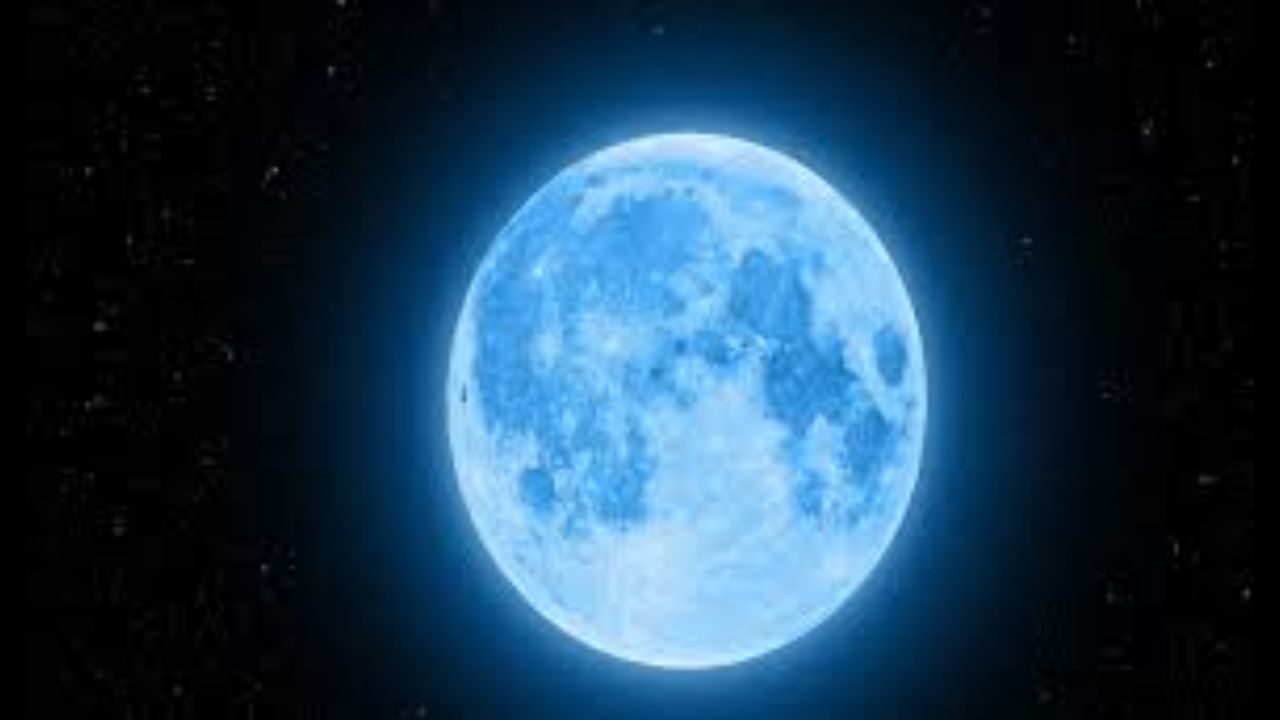Get Ready for the Supermoon Blue Moon Spectacle: The next full Moon will occur on Wednesday, August 30, 2023, appearing opposite the Sun (in Earth-based longitude) at 9:36 p.m. EDT. The planet Saturn, which is just a few days away from its nearest and brightest point of the year, will be visible near the Moon. At the conclusion of evening twilight (at 8:42 PM), Saturn will be 5 degrees to the Moon’s upper right and will appear to orbit the Moon clockwise as the evening progresses. The Moon will appear full for three days surrounding the full Moon, from Tuesday evening until Friday morning.
This moon will be supersized. Publications use varying criteria to determine which full Moons qualify as “super,” but all concur that the two full Moons in August of 2023 qualify.
This will be the second full Moon in August, making it a Blue Moon according to the definition introduced by Sky & Telescope in 1946. The older definition of Blue Moon, which dates back to at least the 1500s, refers to the third full Moon of a four-Moon season. By this definition, the full Moon in August 2024 will be a Blue Moon, and as the last full Moon of summer, it will share some seasonal designations with the full Moon on August 1. These definitions have nothing to do with the colour of the Moon, so the Blue Moon will not be blue. Learn more about a time when the Moon genuinely turned blue at https://www.nasa.gov/vision/universe/watchtheskies/07jul_bluemoon.html.
This full Moon coincides with the Hindu festival Raksha Bandhan, also known as Rakhi or Rakhi Purnima, which celebrates the brother-sister bond. As a sign of their continued bond, sisters of all ages are expected to bind a rakhi (a cotton bracelet) around their brother’s wrist and receive a gift in return. The literal translation of “Raksha Bandhan” is “the bond of protection, obligation, or care.”
In a number of traditional lunisolar and lunar calendars, full Moons occur close to the centre of the lunar month. This full Moon occurs in the midst of the seventh month of the Chinese, Islamic, and Hebrew calendars. Elul is a period of preparation for Rosh Hashanah and Yom Kippur, the High Holy Days. Customs include granting and requesting forgiveness, as well as wishing the recipient a happy new year at the beginning or conclusion of all correspondence.
As usual, celebratory celestial attire is encouraged to be worn in honour of the full Moon. Take care of your siblings, release grievances, and have a prosperous year!
As for other celestial events between now and the next full Moon (with specific times and angles based on NASA Headquarters’ location in Washington, D.C.):
As summer draws to a close and autumn begins, the daily periods of sunlight continue to diminish, with the rate of change accelerating around the autumnal equinox.
On Wednesday, August 30, 2023 (the day of the full Moon), morning twilight will commence at 5:35 AM EDT, sunrise will occur at 6:35 AM, solar noon will occur at 1:09 PM when the Sun reaches its highest altitude of 60.0 degrees, sunset will occur at 7:42 PM, and evening twilight will conclude at 8:42 PM. On Saturday, September 23, the autumn equinox will occur with sunrise at 6:57 AM and sunset at 7:04 PM. On Friday, September 29 (the day after the next full Moon), morning twilight will begin at 6:04 AM, sunrise will occur at 7:02 AM, solar noon will occur at 12:58 PM when the Sun reaches its highest altitude of 48.6 degrees, sunset will occur at 6:54 PM, and evening twilight will conclude at 7:52 PM.
During this lunar cycle, no significant meteor showers are predicted to reach their peak. Under ideal conditions, three minor meteor showers will peak with six or fewer visible meteors per hour (effectively not visible from our brightly illuminated urban areas).
Get Ready for the Supermoon Blue Moon Spectacle: Nighttime Sky Highlights:
On the evening of Wednesday, August 30, 2023 (the night of the full Moon), when evening twilight concludes (at 8:42 PM EDT), the rising Moon will be 8 degrees above the east-southeast horizon, and Saturn will be 5 degrees to the upper right. On the western horizon, Mars will be setting. At 85 degrees above the eastern horizon, the brightest star appearing closest to overhead will be Vega. Vega, the brightest star in the constellation Lyra the lyre, is one of the three brilliant stars that make up the Summer Triangle, along with Deneb and Altair. Vega is the fifth brightest star in our night sky, is located approximately 25 light-years from Earth, has twice the mass of the Sun, and is 40 times luminous than the Sun.
As this lunar cycle progresses, the background of stars and Saturn will appear to travel westward each evening (as the Earth revolves around the Sun), whereas Mars will move more slowly on the western horizon. Mars will be below the horizon when evening twilight ends after September 1. The waxing Moon will pass by Spica on September 17 (difficult to see as it will set shortly after dusk), Antares on September 20 and Saturn on September 26.
As evening twilight ends at 7:53 PM EDT on Thursday, September 28 (the start of the night of the next full Moon), the rising Moon will be 12 degrees above the east-southeast horizon. Saturn will be located 23 degrees above the southeast horizon. At 83 degrees above the western horizon, Vega will appear to be the brightest star nearest to the sky.
Morning Sky Emphasis:
As morning twilight begins at 5:36 AM EDT on Thursday, August 31, 2023 (the morning of the night of the full Moon), the Moon will be 14 degrees above the west-southwest horizon as it sets. The planet Saturn will be 7 degrees above the west-southwest horizon, to the Moon’s lower right. Jupiter will be dazzling at 66 degrees above the southern horizon, and Venus will be even brighter at 9 degrees above the eastern horizon. At 66 degrees, Jupiter will be the brightest object directly overhead, followed closely by the bright star Capella at 65 degrees above the east-northeast horizon.
Each evening, Venus, Jupiter, Saturn, and the background stars will appear to migrate westward as this lunar cycle progresses. On September 8, Saturn will no longer be visible in the sky as morning twilight begins. Mercury will join Venus and Saturn in rising before morning twilight on September 14. Mercury will initially be difficult to see, but will rapidly intensify each morning. Venus will be at its brightest on September 19 (when Venus is at its brightest, it is visible during the day). Mercury will attain its greatest angular separation from the Sun on September 22 and will appear at its highest above the horizon on September 23 as morning twilight begins. On September 4, Pollux, on September 10, Venus on September 11 and 12, and Regulus on September 13, the waning Moon will pass close to Jupiter.
As morning twilight begins at 6:04 AM EDT on Friday, September 29 (the morning of the next full Moon), the setting full Moon will be 11 degrees above the western horizon. Venus (the brightest) will be 29 degrees above the eastern horizon, Jupiter will be 48 degrees above the west-southwest horizon, and Mercury will be 4 degrees above the eastern horizon (the faintest). Capella, 83 degrees above the north-northwest horizon, will be the brightest star appearing nearest to overhead. The brightest star in the constellation Auriga the Charioteer is Capella. Although we observe Capella as a single star (the sixth brightest in our night sky), it is actually comprised of four stars (two pairs of stars that orbit each other). Capella is 43 light-years away from us.
Comprehensive Daily Guide:
Here is a day-by-day listing of celestial events between now and the next full Moon for your reference. The times and angles are based on the location of NASA Headquarters in Washington, DC; some of these details may vary for your location (I use brackets to denote times specific to the DC region).
On Thursday night, August 24, 2023, the luminous star Antares will appear close to the half-full Moon, so close that the Moon will pass in front of Antares for much of Canada, the United States, and northern Mexico. At the conclusion of evening twilight in Washington, DC (at 8:52 PM EDT), Antares will be one degree to the left of the Moon. About an hour later, at 10:53 p.m., Antares will recede behind the Moon’s night side. Antares will reappear from the underside of the Moon approximately 45 minutes later (around 11:41 PM), but this reappearance will initially be obscured by the Moon’s bright limb. Antares will be the first object to set on the west-southwest horizon 14 minutes later, at 11:55 p.m. Visit http://www.lunar-occultations.com/iota/bstar/0824zc2366.htm for more information regarding this occultation in your region.
Saturday morning, August 27, 2023, Saturn will be at its closest and brightest for the year, a phenomenon referred to as “opposition” because it will be opposite the Earth from the Sun, resulting in a “full” Saturn. Saturn will be 10 degrees above the east-southeast horizon as evening twilight concludes on Friday, August 26 (at 8:48 PM EDT); it will reach its highest point in the sky early Saturday morning (at 1:13 AM); and it will be 11 degrees above the west-southwest horizon as dawn begins on Saturday, August 27 (at 5:01 AM). At opposition, only planets that orbit farther from the Sun than Earth are visible from Earth.
At 11:55 AM EDT on Wednesday, August 30, 2023, the Moon will reach perigee, its closest point to the Earth during this orbit.
On Wednesday night and Thursday morning, August 30 and 31, 2023, the planet Saturn will appear close to the full supermoon, just a few days from its closest and brightest for the year. At the conclusion of evening twilight (8:42 p.m. EDT), the Moon will be 8 degrees above the east-southeast horizon, while Saturn will be 5 degrees to the upper right. Saturn will appear to circle the Moon in a clockwise direction as the night progresses. The Moon will reach its zenith 4.5 hours later, at 1:23 a.m. on Thursday, with Saturn 7 degrees to the right. By the time dawn breaks (5:36 AM), the Moon will be 14 degrees above the west-southwest horizon, while Saturn will be 8 degrees to the lower right.
The next full Moon will occur on Wednesday, August 30, 2023, at 9:36 p.m. EDT, when it will appear opposite the Sun (in Earth-based longitude). The Moon will appear full for three days surrounding the full Moon, from Tuesday night to Friday morning. This will be the second full Moon in August, making it a Blue Moon according to the definition introduced by Sky & Telescope in 1946. This full Moon is a supermoon because it occurs close to the Moon’s perigee, or closest point to the Earth.
Friday, September 1, 2023 will be the final evening that Mars will be visible above the western horizon as evening twilight ends (at 8:38 PM EDT), setting one minute later.
Sunday evening through Monday morning, September 3 and 4, 2023, Jupiter will appear close to the waxing gibbous Moon. At 10:16 p.m. EDT, Jupiter will be 8 degrees to the lower left of the Moon as it rises above the east-northeast horizon. 6.5 hours later, at 4:45 AM, the Moon will reach its highest point in the sky for the night, with Jupiter 6 degrees to the Moon’s left. At 5:40 AM, morning twilight will commence approximately one hour later.
By the evening of Monday, September 4, 2023, the gibbous Moon will have shifted to the opposite side of Jupiter. Jupiter will be 6 degrees to the right of the Moon as it rises on the east-northeast horizon at 10:14 p.m. EDT. As the night progresses, the two will separate.
Wednesday morning, September 6, 2023, Mercury will pass between the Earth and the Sun as seen from Earth, a phenomenon known as inferior conjunction. Planets that orbit within the Earth’s orbit can experience two varieties of conjunctions with the Sun: inferior (when passing between the Earth and the Sun) and superior (when passing on the far side of the Sun). Mercury will transition from the evening sky to the morning sky and will begin to emerge from the glow of dawn on the eastern horizon around the middle of September (depending on the observing conditions).
At 6:21 pm EDT on Wednesday, September 6, 2023, the Moon will appear half-full as it reaches its last quarter.
Friday morning, September 8, 2023, will be the final morning that Saturn will be visible above the horizon as dawn approaches.
On Sunday morning, September 10, 2023, the brilliant star Pollux will appear above the crescent Moon that is waning. At 2:10 AM EDT, when the Moon rises over the northeastern horizon, Pollux will be three degrees above the Moon. Bright Venus will ascend two hours later (at 4:07 AM) in the east-northeast, approximately 20 degrees below the Moon, with Pollux 4 degrees above the Moon. 1.5 hours later, at 5:46 AM, when morning twilight begins, Pollux will be 5 degrees above the Moon, while Venus will be 19 degrees below the Moon. Venus will be 18 degrees to the lower left of the dazzling star Regulus.
The slender, waning crescent Moon will have moved 12 degrees to the upper left of Venus by Monday morning, September 11, 2023.
The slender, waning crescent Moon will have moved 13 degrees to the lower left of Venus by Tuesday morning, September 12, 2023, while the bright star Regulus will be 10 degrees below the Moon.
At 11:43 AM EDT on September 12, 2023, the Moon will reach apogee, its farthest point from the Earth during this orbit.
The bright star Regulus will be 5 degrees to the right of the very slender, waning crescent Moon on Wednesday morning, September 13, 2023. The planet Mercury will be 8 degrees to the Moon’s lower right, but it will be difficult to see because it will rise a few minutes after the start of morning twilight and will not be very luminous (11% illuminated crescent).
Mercury will rise above the horizon for the first time on Thursday, September 14, 2023, just as morning twilight begins. It will be difficult to see initially, as only 14% of its surface will be illuminated, but it will become more visible each morning as the Sun illuminates more of its Earth-facing surface.
The new Moon will occur on September 14, 2023, at 9:40 p.m. EDT, when the Moon passes between the Earth and the Sun and is no longer visible from Earth. In numerous lunisolar calendars, a new month begins on the day of or the day after the New Moon. On September 15, the eighth month of the Chinese calendar will begin.
Rosh Hashanah (the Head of the Year), the two-day Jewish New Year celebration, will begin at sundown on Friday, September 15, 2023, and conclude on Sunday, September 17, 2023. In Tishrei, the first month of the Hebrew calendar, Rosh Hashanah is the first of several festivals. Yom Kippur, the Day of Atonement, is observed on the eleventh day of Tishrei. The 10 days between Rosh Hashana and Yom Kippur, known as thea€ ‘Days of Awe, are a time to reflect on past errors and lessons and to make resolutions for the coming year. The seven-day Sukkot holiday begins on the fifteenth day of Tishrei, which is near to the following full moon.
In the Islamic calendar, the first sighting of the waxing crescent Moon marks the beginning of each month. Numerous Muslim communities now adhere to the Umm al-Qura Calendar of Saudi Arabia, which utilises astronomical calculations for more predictable month beginnings. According to this calendar, Rabi’ al-Awwal, the third month of the Islamic calendar, will likely commence at sundown on Friday, September 15, 2023. During this month, some Muslims observe Mawlid, Muhammad’s birthday.
If you have a very clear view of the west-southwest horizon on Sunday evening, September 17, 2023, you may be able to see the bright star Spica 3 degrees to the lower right of the slender, waxing crescent Moon. They may be hard to spot. You would need to observe before evening twilight ends, as Spica will be close to setting and the Moon will be only 2 degrees above the horizon when evening twilight ends (at 8:11 PM EDT). At 8:28 p.m., the Moon will set 17 minutes later.
The solar day from solar noon on Monday, September 18, 2023, to solar noon on Tuesday, September 19, 2023, will be the shortest of the year. With a duration of 23 hours, 59 minutes, 38.6 seconds, it will be 21.4 seconds shorter than the 24 hour average utilised by contemporary timepieces.
On Tuesday, September 19, 2023, Venus will be at its brightest for the year, which is a reasonable approximation of when Venus will be the brightest. On the basis of the distances and angles between the Sun, Venus, and the Earth, the maximum brilliance is calculated using a simplification of how Venus scatters sunlight. Venus is visible during the day (if the sky is unobstructed and you know where to look) when it is bright. The brightest period occurs approximately 36 days before and after inferior conjunction.
On Wednesday evening, September 20, 2023, the brilliant star Antares will appear to the Moon’s upper left. At the conclusion of twilight (at 8:06 p.m. EDT), Antares will be 5 degrees from the Moon. Antares will be 4 degrees from the Moon when it sets on the west-northwest horizon at 9:57 p.m., less than 2 hours later. For more information, see http://www.lunar-occultations.com/iota/bstar/0921zc2366.html.
By the time evening twilight concludes on Thursday, September 21, 2023, the Moon will have moved 8 degrees to the opposite side of Antares. As evening progresses, the couple will separate.
The planet Mercury will attain its greatest angular separation from the Sun as seen from Earth for this apparition on Friday morning, September 22, 2023 (called greatest elongation). Because the angle of the line between the Sun and Mercury and the horizon varies with the seasons, the date when Mercury and the Sun appear farthest apart as seen from Earth is not always the same as the date when Mercury appears highest above the eastern horizon as morning twilight begins, which occurs the following morning on September 23.
At 3:32 p.m. EDT on Friday, September 22, 2023, the Moon will appear half-full as it reaches its first quarter.
The autumnal equinox will occur at 2:50 AM EDT on September 23, 2023, marking the astronomical end of summer and beginning of autumn. This year, the Sun will move from the Northern to the Southern Hemisphere, crossing the equator over the Indian Ocean.
OSIRIS-REx, a mission on which I worked before retiring from NASA, will deliver a surface sample from the asteroid Bennu to Earth on September 24, 2023. At 10 a.m. EDT, NASA’s Live coverage of the capsule landing will begin.
On Tuesday evening, September 26, 2023, and Wednesday morning, September 27, 2023, Saturn will appear close to the waxing gibbous Moon. When evening twilight concludes (at 7:56 PM EDT), Saturn will be 4 degrees to the Moon’s upper left. By the time the Moon reaches its nighttime zenith roughly three hours later (at 11:07 PM), Saturn will be located three degrees to the upper right. When Saturn sets below the west-southwest horizon approximately 5 hours later, at 4:24 AM, it will be 4 degrees to the Moon’s lower right.
Wednesday, September 27, 2023 at 9:06 p.m. EDT, the Moon will reach perigee, its closest approach to the Earth during this orbit.
The next full Moon will occur on September 29, 2023, at 5:58 AM EDT, appearing opposite the Sun (in Earth-based longitude). This will be late Thursday night from Hawaii and the Cook Islands westward to the International Date Line. Around this time, the Moon will be full for three days, from Wednesday evening to Saturday morning.




